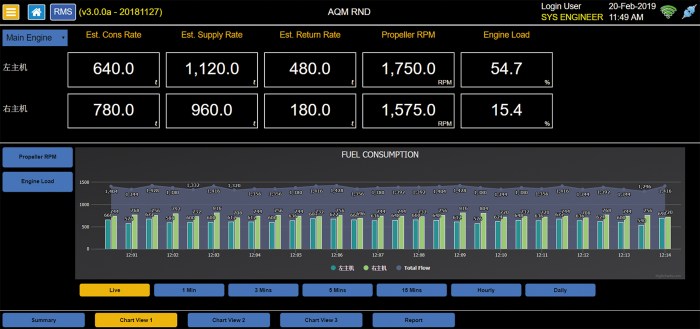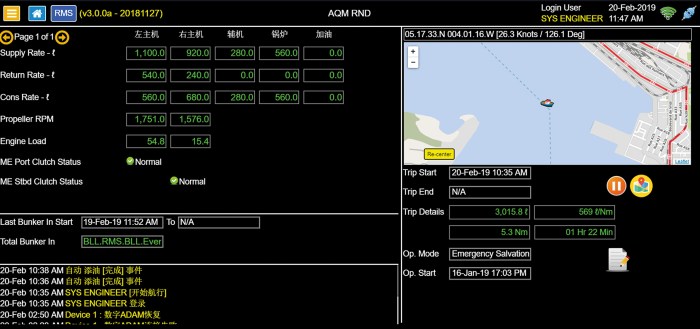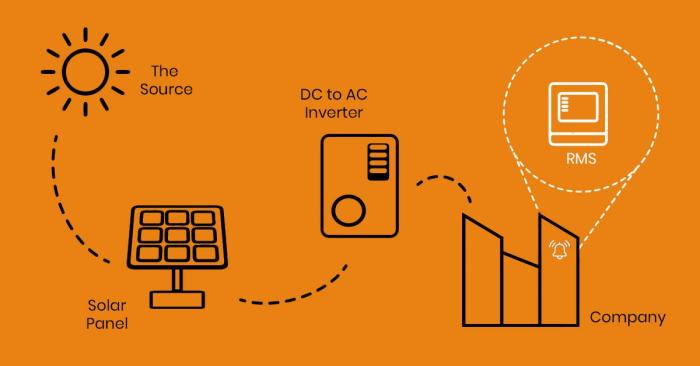What is a Remote Monitoring System (RMS)? In today’s interconnected world, businesses across industries are increasingly relying on remote monitoring systems (RMS) to gain real-time insights into their operations. RMS empowers organizations to gather, analyze, and act upon data from various sources, optimizing efficiency, reducing downtime, and enhancing safety.
This comprehensive guide explores the intricacies of RMS, delving into its core functions, components, benefits, challenges, and future trends.
Imagine a system that allows you to monitor your entire production line from anywhere in the world, instantly identifying potential issues before they escalate into major problems. This is the power of a remote monitoring system. By leveraging advanced technologies like sensors, data analytics, and cloud computing, RMS provides a comprehensive view of critical operations, enabling proactive decision-making and improved resource allocation.
What is a Remote Monitoring System (RMS)?
Remote monitoring systems (RMS) are essential tools for businesses and organizations across various industries. These systems allow for the continuous observation and control of critical assets, processes, and environments from a remote location.
Core Function of an RMS
An RMS primarily collects data from sensors and devices deployed in the field. This data is then transmitted to a central monitoring station, where it is analyzed and interpreted. Based on the data analysis, the RMS can trigger alerts, generate reports, and even initiate automated responses to ensure optimal performance and prevent potential issues.
Benefits of Implementing an RMS
Implementing an RMS offers a wide range of advantages for businesses and organizations, including:
- Enhanced Efficiency and Productivity:By providing real-time insights into operational processes, RMS allows businesses to optimize resource allocation, streamline workflows, and reduce downtime.
- Improved Asset Management:RMS enables organizations to monitor the health and performance of their assets, schedule preventive maintenance, and minimize unexpected failures, ultimately extending asset lifespan and reducing costs.
- Enhanced Safety and Security:RMS plays a crucial role in ensuring the safety of personnel and assets by providing early warning systems for potential hazards and security breaches. This proactive approach helps minimize risks and prevent accidents.
- Cost Savings:By enabling proactive maintenance and reducing downtime, RMS significantly reduces operational costs. Additionally, the ability to remotely monitor and control assets eliminates the need for on-site personnel, further contributing to cost savings.
- Increased Compliance:RMS can help organizations comply with industry regulations and standards by providing comprehensive data logging and reporting capabilities. This ensures transparency and accountability in operations.
Real-World Applications of RMS, What is a Remote Monitoring System (RMS)?
RMS has found applications across various sectors, including:
- Industrial Automation:RMS is widely used in manufacturing, energy, and other industrial sectors to monitor critical processes, such as temperature, pressure, and flow rates. This allows for real-time optimization of production lines, improved quality control, and reduced energy consumption.
- Building Management:RMS plays a vital role in building management systems, enabling remote monitoring of HVAC systems, lighting, security, and other building functions. This ensures energy efficiency, occupant comfort, and security.
- Environmental Monitoring:RMS is used to monitor air and water quality, weather conditions, and other environmental parameters. This data is crucial for environmental protection, disaster preparedness, and research.
- Healthcare:In healthcare, RMS is used to monitor patient vitals, medical equipment, and medication dispensing systems. This ensures patient safety, improves care quality, and reduces the risk of medical errors.
- Transportation:RMS is used in transportation to monitor vehicle fleets, track cargo shipments, and manage traffic flow. This improves efficiency, safety, and reduces fuel consumption.
Components of a Remote Monitoring System (RMS): What Is A Remote Monitoring System (RMS)?
A remote monitoring system (RMS) is comprised of various components that work together to collect, process, analyze, and present data about a monitored system or process. These components are essential for the effective operation and management of an RMS.
Sensors and Data Acquisition
Sensors are the core of any RMS, as they are responsible for collecting data about the monitored system. These devices convert physical parameters, such as temperature, pressure, vibration, or flow, into electrical signals that can be transmitted to the RMS.
- Sensors can be wired or wireless, depending on the specific application and requirements.
- The type of sensor used depends on the parameter being monitored and the accuracy required.
- Data acquisition involves the process of collecting data from sensors and converting it into a format that can be processed and analyzed by the RMS.
- This process typically involves using data loggers, which are devices that store and transmit data collected from sensors.
Types of Remote Monitoring Systems (RMS)

Remote monitoring systems (RMS) are categorized based on their functionalities, applications, and the specific technologies employed. Understanding these categories helps in choosing the most appropriate RMS for a particular application and environment.
Categorization of RMS Based on Functionalities
The various types of RMS are categorized based on their functionalities and applications. Here’s a breakdown:
- Environmental Monitoring Systems:These systems monitor environmental parameters such as temperature, humidity, air quality, and water levels. They are widely used in industries like agriculture, manufacturing, and data centers to ensure optimal conditions and prevent potential hazards. For example, a greenhouse can utilize an environmental monitoring system to track temperature, humidity, and light levels, adjusting these parameters automatically to optimize plant growth.
- Security Monitoring Systems:These systems focus on monitoring security aspects like access control, intrusion detection, and video surveillance. They are essential for protecting assets and personnel in various environments, including homes, businesses, and critical infrastructure. For instance, a bank can implement a security monitoring system to monitor its premises, detect any unauthorized entry attempts, and trigger alarms if necessary.
- Asset Monitoring Systems:These systems track the location, condition, and performance of assets like vehicles, equipment, and machinery. They are widely used in logistics, transportation, and manufacturing industries to improve efficiency, reduce downtime, and optimize resource utilization. For example, a fleet management company can use an asset monitoring system to track the location and fuel consumption of its vehicles, allowing for efficient route planning and optimized fuel usage.
- Process Monitoring Systems:These systems focus on monitoring industrial processes and operations, collecting data on parameters like pressure, flow, and temperature. They are crucial for ensuring process stability, optimizing production, and detecting potential issues early. For instance, a chemical plant can use a process monitoring system to track the temperature and pressure within its reactors, ensuring safe and efficient operation.
- Health Monitoring Systems:These systems are used for monitoring patient health parameters like heart rate, blood pressure, and oxygen levels. They are increasingly employed in healthcare settings for remote patient monitoring, enabling timely intervention and improved patient outcomes. For example, a diabetic patient can use a health monitoring system to track their blood sugar levels remotely, allowing their healthcare provider to monitor their condition and provide appropriate care.
Advantages and Limitations of Different RMS Types
Each type of RMS offers distinct advantages and limitations:
- Environmental Monitoring Systems:
- Advantages:Early detection of environmental changes, prevention of potential hazards, improved efficiency and productivity.
- Limitations:High initial investment, complex setup, potential for false alarms.
- Security Monitoring Systems:
- Advantages:Enhanced security, reduced risk of theft and vandalism, improved response times.
- Limitations:High installation costs, potential for system failures, privacy concerns.
- Asset Monitoring Systems:
- Advantages:Improved asset utilization, reduced downtime, enhanced logistics and supply chain management.
- Limitations:High initial investment, potential for signal interference, data security concerns.
- Process Monitoring Systems:
- Advantages:Improved process control, enhanced efficiency and productivity, early detection of potential issues.
- Limitations:Complex integration with existing systems, high maintenance costs, potential for system downtime.
- Health Monitoring Systems:
- Advantages:Improved patient care, early detection of health issues, increased patient independence.
- Limitations:Privacy concerns, potential for data breaches, reliance on technology and internet connectivity.
Examples of Specific RMS Technologies and Use Cases
- Internet of Things (IoT) Sensors:IoT sensors are used in various RMS applications, collecting data on temperature, humidity, pressure, and other parameters. For example, IoT sensors can be used in a manufacturing plant to monitor the temperature of machinery, preventing overheating and potential failures.
- Global Positioning System (GPS) Tracking:GPS tracking systems are commonly used in asset monitoring systems, providing real-time location data for vehicles, equipment, and other assets. For example, a logistics company can use GPS tracking to monitor the location of its delivery trucks, optimizing routes and ensuring timely deliveries.
- Video Surveillance Systems:Video surveillance systems are widely used in security monitoring applications, providing real-time video feeds of monitored areas. For example, a retail store can use video surveillance to monitor its premises, deter theft, and investigate incidents.
- Cloud-Based Monitoring Platforms:Cloud-based platforms offer a centralized location for storing and analyzing data from various RMS applications. These platforms provide tools for data visualization, reporting, and alerting, enabling users to gain insights and take appropriate actions. For example, a hospital can use a cloud-based monitoring platform to track patient vital signs, generate reports, and alert medical staff in case of emergencies.
Benefits of Implementing a Remote Monitoring System (RMS)

Implementing a remote monitoring system (RMS) can bring significant benefits to businesses across various industries, leading to improved efficiency, cost savings, and enhanced safety. By leveraging real-time data and remote access capabilities, RMS enables organizations to optimize operations, minimize downtime, and proactively address potential issues.
Cost Savings and Improved Efficiency
Implementing an RMS can lead to substantial cost savings and efficiency improvements by streamlining operations and reducing downtime. The system’s ability to monitor equipment and processes remotely allows for early detection of issues, enabling timely intervention and preventing costly breakdowns.
“According to a study by the Aberdeen Group, companies with mature remote monitoring programs experience a 20% reduction in maintenance costs and a 15% decrease in downtime.”
Examine how Best Payroll Service For Small Business can boost performance in your area.
- Reduced Maintenance Costs:By detecting potential issues early, RMS enables preventative maintenance, minimizing the need for costly emergency repairs.
- Optimized Asset Utilization:RMS provides insights into asset performance, allowing for better resource allocation and maximizing equipment utilization.
- Streamlined Operations:Remote monitoring systems streamline operational processes by automating tasks, reducing manual intervention, and providing real-time data for informed decision-making.
Enhanced Safety and Risk Mitigation
RMS plays a crucial role in enhancing safety and mitigating risks by providing real-time visibility into potentially hazardous situations. By monitoring critical parameters and detecting anomalies, RMS enables prompt response and intervention, minimizing the likelihood of accidents and ensuring a safer working environment.
“A recent study by the National Safety Council found that organizations using RMS experienced a 10% reduction in workplace accidents.”
- Early Detection of Hazards:RMS monitors critical parameters like temperature, pressure, and vibration, alerting operators to potential hazards before they escalate.
- Remote Intervention:In emergency situations, RMS allows for remote intervention, enabling operators to take corrective actions from a safe distance.
- Improved Incident Response:Real-time data provided by RMS facilitates rapid incident response, minimizing downtime and potential damage.
Challenges in Implementing a Remote Monitoring System (RMS)
Implementing a remote monitoring system (RMS) can bring significant benefits, but it also presents a range of challenges that need to be carefully considered and addressed. This section will delve into the common hurdles encountered during RMS implementation, emphasizing the importance of security and data privacy, and exploring potential technical difficulties and their solutions.
Security and Data Privacy
Security and data privacy are paramount concerns when implementing an RMS. Sensitive data, such as operational parameters, system configurations, and real-time performance metrics, are transmitted and stored remotely, making them vulnerable to unauthorized access, cyberattacks, and data breaches.
- Data Encryption:Implementing strong encryption protocols, such as Transport Layer Security (TLS) or Secure Sockets Layer (SSL), is crucial to protect data transmitted between the remote monitoring system and the monitored devices. This ensures that data is scrambled during transmission, making it unintelligible to unauthorized individuals.
- Access Control:Implementing robust access control measures, such as multi-factor authentication and role-based access control, is essential to restrict access to the RMS to authorized personnel only. This helps prevent unauthorized users from accessing sensitive data or manipulating system configurations.
- Data Backup and Recovery:Regular data backups and disaster recovery plans are essential to ensure data integrity and availability in the event of system failures, cyberattacks, or natural disasters. Implementing a secure data backup and recovery strategy helps minimize data loss and ensure business continuity.
- Compliance with Data Privacy Regulations:Organizations must ensure that their RMS implementation complies with relevant data privacy regulations, such as the General Data Protection Regulation (GDPR) in the European Union or the California Consumer Privacy Act (CCPA) in the United States. This involves implementing measures to protect personal data, obtain informed consent from individuals, and provide transparent data handling practices.
Technical Challenges
Technical challenges are another significant aspect of RMS implementation. These challenges can arise from factors such as network connectivity, device compatibility, data integration, and system scalability.
- Network Connectivity:Reliable and secure network connectivity is essential for effective RMS operation. Poor network connectivity can lead to data transmission delays, system performance issues, and potential data loss. Ensuring reliable network connectivity through redundant connections, network monitoring, and optimization techniques is crucial.
- Device Compatibility:RMS implementation requires compatibility between the monitoring system and the monitored devices. Ensuring that the devices are compatible with the chosen RMS platform, including communication protocols and data formats, is crucial. This may involve upgrading devices, configuring communication protocols, or using specialized gateways to bridge compatibility gaps.
- Data Integration:Integrating data from various sources, such as sensors, controllers, and databases, into a unified RMS platform can be challenging. This requires careful data mapping, data cleansing, and data synchronization to ensure data accuracy and consistency. Utilizing data integration tools and techniques can simplify this process.
- System Scalability:As organizations expand their operations, their RMS needs to scale accordingly to accommodate the increased number of monitored devices, data volume, and user access. Choosing an RMS platform with scalable architecture, flexible deployment options, and robust performance capabilities is crucial to handle future growth and evolving monitoring needs.
Future Trends in Remote Monitoring Systems (RMS)
The landscape of remote monitoring systems (RMS) is constantly evolving, driven by advancements in technology and the increasing demand for enhanced efficiency and real-time insights. The integration of artificial intelligence (AI), the Internet of Things (IoT), and cloud computing is transforming the capabilities of RMS, paving the way for a future where monitoring is more intelligent, predictive, and proactive.
The Role of AI and Machine Learning in RMS
AI and machine learning are poised to revolutionize the way RMS operate. By leveraging these technologies, RMS can become more intelligent and capable of:
- Predictive Maintenance:AI algorithms can analyze historical data from sensors and other sources to identify patterns and predict potential equipment failures before they occur. This allows for proactive maintenance scheduling, reducing downtime and optimizing resource allocation.
- Anomaly Detection:AI-powered systems can detect anomalies in real-time, alerting operators to potential issues that might otherwise go unnoticed. This enhances situational awareness and allows for prompt intervention, preventing costly disruptions.
- Optimized Resource Allocation:AI can analyze data from various sources, including sensor readings, weather conditions, and operational demands, to optimize resource allocation in real-time. This ensures efficient utilization of resources and reduces waste.
Closing Notes

The implementation of a remote monitoring system can be a game-changer for businesses seeking to optimize operations, enhance safety, and gain a competitive edge. By embracing the power of data and leveraging the capabilities of RMS, organizations can unlock new levels of efficiency, reduce costs, and ensure a more sustainable and resilient future.
As technology continues to evolve, RMS is poised to play an increasingly vital role in shaping the landscape of modern businesses, empowering organizations to make informed decisions and achieve their strategic goals.
Expert Answers
What are the different types of remote monitoring systems available?
Remote monitoring systems can be categorized based on their functionalities and applications. Some common types include:
- Industrial RMS:Used for monitoring critical infrastructure, equipment, and processes in manufacturing, energy, and other industrial sectors.
- Environmental RMS:Employed for monitoring environmental conditions like air quality, water levels, and soil health.
- Building Management Systems (BMS):Designed for monitoring and controlling building systems like HVAC, lighting, and security.
- Healthcare RMS:Used for remote patient monitoring, providing real-time data on vital signs and medication adherence.
What are the challenges associated with implementing a remote monitoring system?
While RMS offers numerous benefits, implementing them effectively can pose certain challenges, including:
- Security and Data Privacy:Ensuring the security of sensitive data and maintaining compliance with data privacy regulations is paramount.
- Technical Complexity:Integrating various sensors, software, and communication protocols can be complex and require specialized expertise.
- Cost of Implementation:Implementing a comprehensive RMS can involve significant upfront investment in hardware, software, and integration services.
- Training and Adoption:Training users and ensuring widespread adoption within the organization is crucial for successful implementation.